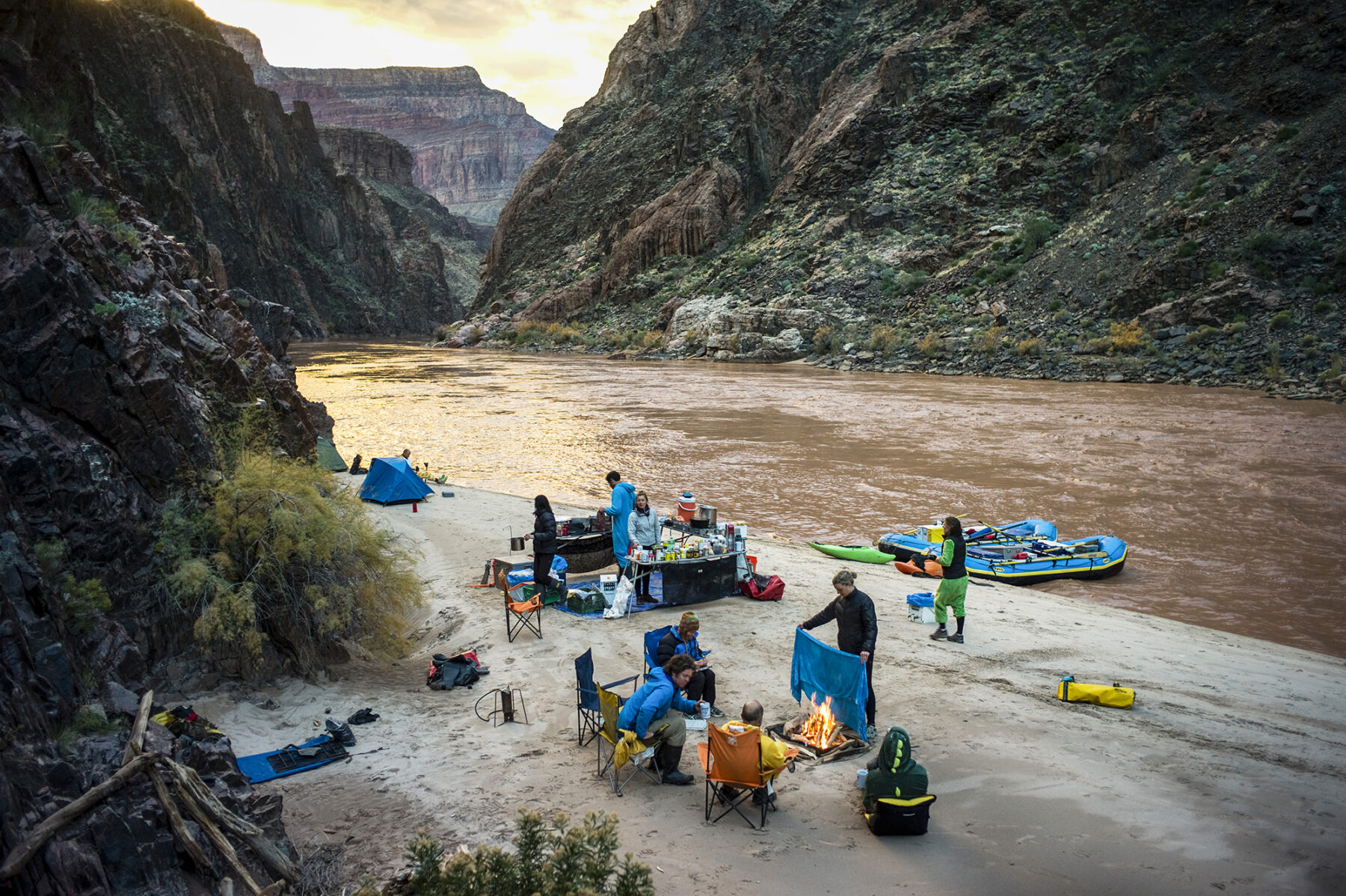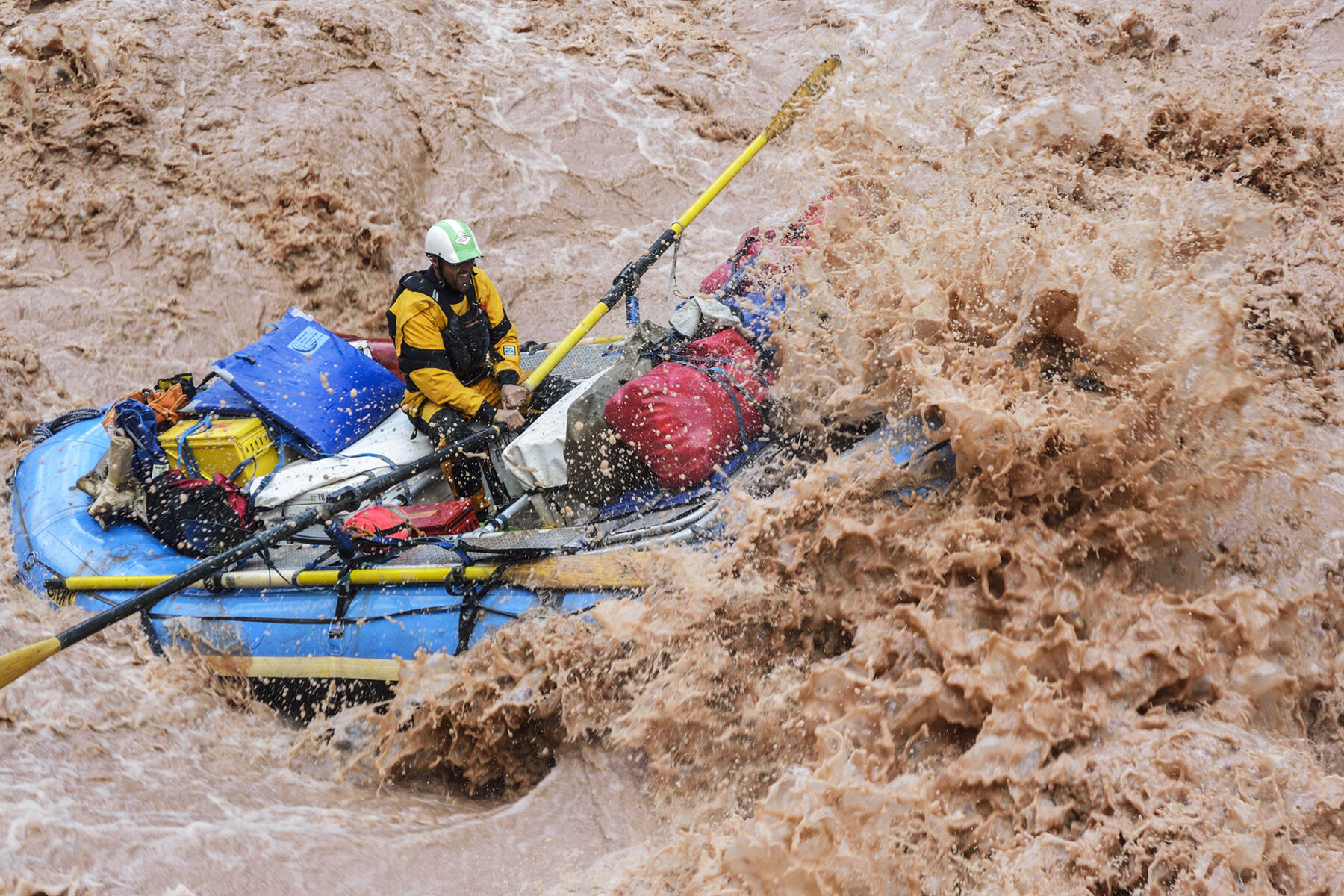The question seemed absurd: “What do you all do you if a condor lands in your campsite?”
Even more absurd was the idea that we were expected to know the answer. As private permit holders for a 21-day, unsupported raft trip down the Grand Canyon’s Colorado River, it seemed a lot was expected of us.
“Rub it on the tummy?” was the answer that broke the silence.
A few people chuckled, which didn’t help.
“You have all watched and understood the instructional DVD now, haven’t you?!”
Dressed in a khaki uniform and bearing a striking resemblance to Smokey Bear, Maggie was the epitome of the US National Parks Service. A strong woman used to dealing with fools. It was obvious that Maggie spent much of her time driving around the park enforcing the myriad rules. She made it clear that she was a woman just as happy to sleep out under the stars as she was to taser anyone who stepped “outta line”.
“Folks aren’t scared of my gun because they think I won’t shoot. But they know I will happily taser ’em,” she warned.

We had met Maggie the day before. We were rigging our rafts in the specially designated area for private groups that were due to launch the following day. She informed us that our permit would be revoked if we didn’t remove our two plastic Pelican cases and a cap from a bench that was for reserved for “day visitors only”.
She was also polite enough, though, to inform us that if our buoyancy vests were not “US Coast Guard Approved” we would not be getting on the river. She then enquired about a host of paperwork that we did not have. It had not started well with Maggie.
Finally, the answer: “Do not ADVANCE TOWARDS the condor, do not FEED the condor, do not ENGAGE WITH the condor, in ANY WAY!”
A canyon grand in every way
The Grand Canyon is 446km long and sinks to a depth of 1600m. A trip through it along the Colorado River is one of the world’s great river trips. Commercial tours run from April to October. There is a weighted, lottery system for private permits and one private trip leaves each day.
We chose to do our trip in autumn so there would be no motorised, commercial trips on the river with us and, being slightly out of prime season, our odds in the lottery would be higher.
Organising a 21-day river trip is a bit like organising a wedding in another country, and then kicking on for the honeymoon, for another three weeks with 14 of your mates. Thankfully, there are many outfitting companies that are set up to sort out all the issues and supply everything you need. Yes, everything.
Our outfitters supplied all the rafts and associated gear, and all food and cooking equipment. The menu alone stretched to over one hundred pages. The company picked us up at our hotel and drove us, and all our gear, to the river in a semi-trailer. Best of all, they provided a concierge service to help us navigate through the ocean of questions from Ranger Maggie.

Against the seemingly impossible khaki-clad odds we made it onto the river, leaving Lees Ferry only a few hours late and drifting quietly but excitedly towards three weeks of adventure. Within the first hour we floated into the immense canyon. What we didn’t know was that we would not emerge again until only a short time before the end of our trip. Our world was to be dominated by vertical walls and slot canyons for the next 21 days.
Everything about the Grand Canyon is big to a point of being almost overwhelming. The canyon walls change colour as you progress down the river, as the water cuts through an array of geology. The guidebook to the river has 50 pages of maps showing all the features and campsites ahead and you can even download a PDF that shows sunrise and sunset times for every campsite for every day of the year.
It’s mind-boggling trying to come to grips with all this information and how much awaits further downstream. Thankfully, our outfitters supplied us with deckchairs and snacks each evening, which we washed down with a variety of adult beverages whilst sitting on the sandy beaches, coming to grips with everything.

The campsites on the river are something to behold; all but one on our trip was a sandy beach. Many are located near some type of off-river feature, whether it be a slot canyon or ruins from the Anasazi people. There are usually trails leading out of the campsites and up onto the cactus-covered terraces allowing sweeping views and endless opportunities for photography.
Paddling the Grand Canyon rapids
Our flotilla consisted of four oar boats – the river equivalent of a large 4WD – a paddleboat – let’s just call it a Suzuki Swift – and five kayaks. No one on the trip had rowed an oar boat before. They were large and heavy. Each one had and Esky large enough to hide a body in and a couple of 9kg gas bottles to power our stoves, along with food and personal gear. We estimated each weighed around a tonne.

It turned out that driving an oar boat down a large rapid was not unlike driving a 4WD. The technique was to line up at the top of the rapid, keep the boat straight and plough through anything that got in the way. The paddleboat however was a completely different story. Paddleboats are rarely used on the canyon and the little Suzuki was not quite up to the task. It was dwarfed by many of the rapids and was often on the verge of flipping.
The Grand Canyon is known for its large volume – but not overly technical – rapids. In short, the lines down the rapids are not difficult, but if you do make a mistake you will most likely end up in a house-sized hole that will eat you and your raft alive. It will then spit you out looking something like a re-use shop. You, your friends and all your worldly belonging then usually face a long swim in the fast, freezing water.

It is the temperature of the water that is the biggest risk and the cause of many of the deaths on the river. The water is released from the bottom of Glen Canyon Dam and averages a temperature of around 5 degrees year round. The shock of falling into water this cold, and the fast onset of hypothermia, is a real danger.
The idea of blowing my dry-suit up so I resembled a Michelin Man had never really occurred to me but, when my friend and guide of our paddle boat, Marcus, suggested it, it seemed perfectly reasonable. I pulled on the rubber gasket around my neck and blew down into my suit until I was red in the race and my arms and legs were swollen to absurd proportions.
There was no question in our minds what was about to happen. The Suzuki Swift was going to be eaten alive. We were at the top of the famed Lava Falls rapid – the river’s largest rapid – and we were about to get a pasting in our little boat. The decision to paddle the rapid was based solely on the idea that 20 seconds of sheer terror was better than one hour lugging the raft along a portage track.

Lava Falls had surprised us, as it was considerably larger than all the other rapids on the river and at the current river level, there was no obvious or easy line through it. It was a messy rapid of large, exploding waves and even larger holes. If you google “Lava Falls” you can spend quite a while on Youtube watching the many hapless fools who have ended up in the “white room” halfway down. We were about to join those ranks. So certain of our fate, we had determined that only two people should be in the raft – fewer people to rescue.
I had almost doubled in size by inflating my dry suit, but I was feeling smaller than ever as we headed out into the main current. We had a plan: paddle hard into the first large wave, crash through it and repeat, until the inevitable, then swim for our lives. We went up the face of the wave looking something like the fishing boat in The Perfect Storm. We were in a great position and we hit the exploding top of the wave with all we had. In a nanosecond it became crystal clear that all we had was nowhere near enough. Our little raft was thrown sideways through the air about four meters. In heroic fashion I fell backwards into the middle of the raft. I may have squealed.
We still had around 100m of rapids to go. Marcus yelled at me; I yelled back. It seems men like yelling when they think the worst is coming. For the next 20 seconds our raft pulled more moves than an aerial ski jumper. We yelled and yelled, but somehow, against the odds, stayed upright. One of the truly great things about big whitewater is that no one can hear you screaming, and acts of mediocrity and sheer stupidity can sometimes be confused with skill and bravery.
Life on the Colorado River
Three weeks allows plenty of time to get into the rhythm of river life. It’s a simple life, and after the first few days, the anxiety and trepidation flows away. The days are spent floating along in awe of the surroundings. The afternoons are set aside for exploring the side canyons and Native American ruins. The canyon is a place where you often feel small, really small, but in a good way.

Trips down the canyon vary greatly. In summer, the temperatures soar and the river level rises and falls as the water is used to power the air conditioners of Las Vegas. In winter, it’s a battle to find sun, which only reaches the canyon floor for a short time each day.

Despite the volume of people who raft the river each year (approximately 30,000) it is impressively clean and, I guess, we have Maggie and the US Parks Service to thank for that. Sometimes all those rules have a purpose. I would, however, love to rub a condor’s tummy, just once.
The essentials
Getting there: Trips on the Grand Canyon leave from two places: Flagstaff, Arizona and Las Vegas, Nevada. Flagstaff is a great mountain town with lots of other outdoor activities nearby. Vegas has casinos.
Access: National Park Service
Gear hire: We used Canyon REO. The service was exceptional and very reasonably priced.
Guide book: The RiverMaps Guide to the Colorado River in the Grand Canyon is a must-have guidebook. It’s durable and waterproof with USGS topo maps and excellent descriptions of river features.
Time out: The number of activities and destinations within a few hours drive of Flagstaff are amazing. The mountain biking at Sedona is especially good.



